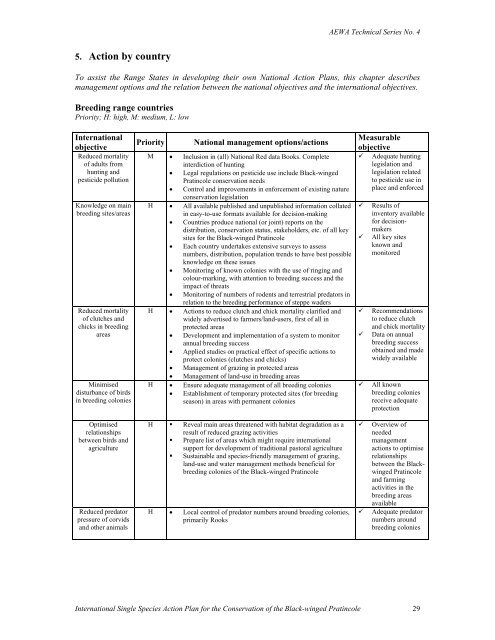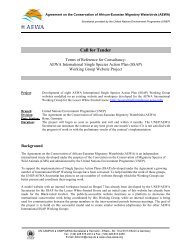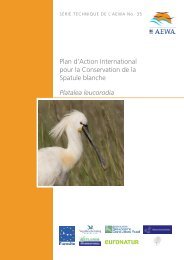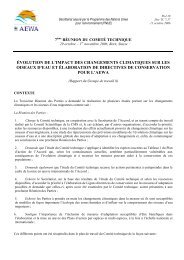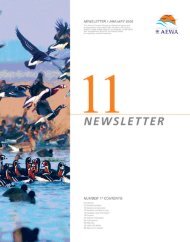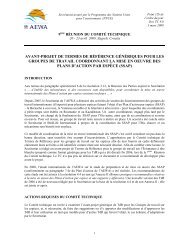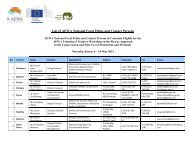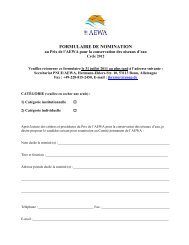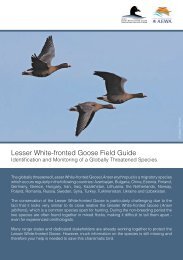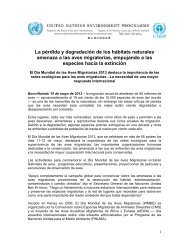Black-winged Pratincole - AEWA
Black-winged Pratincole - AEWA
Black-winged Pratincole - AEWA
Create successful ePaper yourself
Turn your PDF publications into a flip-book with our unique Google optimized e-Paper software.
<strong>AEWA</strong> Technical Series No. 4<br />
5. Action by country<br />
To assist the Range States in developing their own National Action Plans, this chapter describes<br />
management options and the relation between the national objectives and the international objectives.<br />
Breeding range countries<br />
Priority; H: high, M: medium, L: low<br />
International<br />
objective<br />
Reduced mortality<br />
of adults from<br />
hunting and<br />
pesticide pollution<br />
Knowledge on main<br />
breeding sites/areas<br />
Reduced mortality<br />
of clutches and<br />
chicks in breeding<br />
areas<br />
Minimised<br />
disturbance of birds<br />
in breeding colonies<br />
Priority<br />
National management options/actions<br />
M • Inclusion in (all) National Red data Books. Complete<br />
interdiction of hunting<br />
• Legal regulations on pesticide use include <strong>Black</strong>-<strong>winged</strong><br />
<strong>Pratincole</strong> conservation needs<br />
• Control and improvements in enforcement of existing nature<br />
conservation legislation<br />
H • All available published and unpublished information collated<br />
in easy-to-use formats available for decision-making<br />
• Countries produce national (or joint) reports on the<br />
distribution, conservation status, stakeholders, etc. of all key<br />
sites for the <strong>Black</strong>-<strong>winged</strong> <strong>Pratincole</strong><br />
• Each country undertakes extensive surveys to assess<br />
numbers, distribution, population trends to have best possible<br />
knowledge on these issues<br />
• Monitoring of known colonies with the use of ringing and<br />
colour-marking, with attention to breeding success and the<br />
impact of threats<br />
• Monitoring of numbers of rodents and terrestrial predators in<br />
relation to the breeding performance of steppe waders<br />
H • Actions to reduce clutch and chick mortality clarified and<br />
widely advertised to farmers/land-users, first of all in<br />
protected areas<br />
• Development and implementation of a system to monitor<br />
annual breeding success<br />
• Applied studies on practical effect of specific actions to<br />
protect colonies (clutches and chicks)<br />
• Management of grazing in protected areas<br />
• Management of land-use in breeding areas<br />
H • Ensure adequate management of all breeding colonies<br />
• Establishment of temporary protected sites (for breeding<br />
season) in areas with permanent colonies<br />
Measurable<br />
objective<br />
Adequate hunting<br />
legislation and<br />
legislation related<br />
to pesticide use in<br />
place and enforced<br />
<br />
<br />
<br />
<br />
<br />
Results of<br />
inventory available<br />
for decisionmakers<br />
All key sites<br />
known and<br />
monitored<br />
Recommendations<br />
to reduce clutch<br />
and chick mortality<br />
Data on annual<br />
breeding success<br />
obtained and made<br />
widely available<br />
All known<br />
breeding colonies<br />
receive adequate<br />
protection<br />
Optimised<br />
relationships<br />
between birds and<br />
agriculture<br />
Reduced predator<br />
pressure of corvids<br />
and other animals<br />
H • Reveal main areas threatened with habitat degradation as a<br />
result of reduced grazing activities<br />
• Prepare list of areas which might require international<br />
support for development of traditional pastoral agriculture<br />
• Sustainable and species-friendly management of grazing,<br />
land-use and water management methods beneficial for<br />
breeding colonies of the <strong>Black</strong>-<strong>winged</strong> <strong>Pratincole</strong><br />
H • Local control of predator numbers around breeding colonies,<br />
primarily Rooks<br />
<br />
<br />
Overview of<br />
needed<br />
management<br />
actions to optimise<br />
relationships<br />
between the <strong>Black</strong><strong>winged</strong><br />
<strong>Pratincole</strong><br />
and farming<br />
activities in the<br />
breeding areas<br />
available<br />
Adequate predator<br />
numbers around<br />
breeding colonies<br />
International Single Species Action Plan for the Conservation of the <strong>Black</strong>-<strong>winged</strong> <strong>Pratincole</strong> 29


